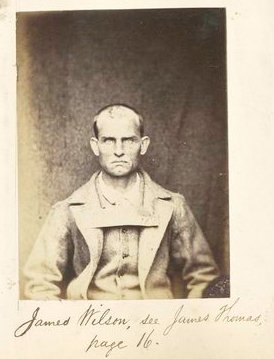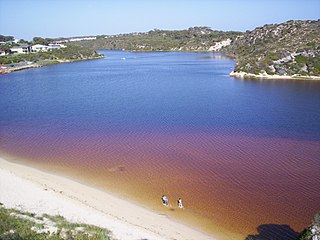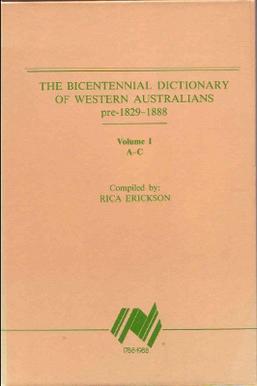
Yagan was an Aboriginal Australian warrior from the Noongar people. Yagan was pursued by the local authorities after he killed Erin Entwhistle, a servant of farmer Archibald Butler. It was an act of retaliation after Thomas Smedley, another of Butler's servants, shot at a group of Noongar people stealing potatoes and fowls, killing one of them. The government offered a bounty for Yagan's capture, dead or alive, and a young settler, William Keats, shot and killed him. He is considered a legendary figure by the Noongar.

John Hutt was Governor of Western Australia from 1839 to 1846.

George Fletcher Moore was a prominent early settler in colonial Western Australia, and "one [of] the key figures in early Western Australia's ruling elite". He conducted a number of exploring expeditions; was responsible for one of the earliest published records of the language of the Australian Aborigines of the Perth area; and was the author of Diary of Ten Years Eventful Life of an Early Settler in Western Australia.
Thomas Timothée Vasse was a French sailor who was lost in the surf on the south west coast of Australia in 1801, and presumed drowned. From Vasse's name is taken the name the Vasse, an early name for Busselton, for the land adjacent to where the incident occurred, the town of Vasse, and also a number of geographical features in the area including Vasse River and Vasse Inlet.

A Descriptive Vocabulary of the Language in Common Use Amongst the [Aboriginals ...] of Western Australia is a book by George Fletcher Moore. First published in 1842, it represents one of the earliest attempts to record the languages used by the Aboriginal peoples of Western Australia. The book is a compilation by Moore based on the works of Robert Lyon, Francis Armstrong, Charles Symmons, the Bussell family and George Grey, as well as his own observations. It was published in 1842 at the expense of Moore and Governor of Western Australia John Hutt. In 1884 it was republished as part of Moore's Diary of Ten Years Eventful Life of an Early Settler in Western Australia and also A Descriptive Vocabulary of the Language of the [Aboriginals ...].

The convict era of Western Australia was the period during which Western Australia was a penal colony of the British Empire. Although it received small numbers of juvenile offenders from 1842, it was not formally constituted as a penal colony until 1849. Between 1850 and 1868, 9,721 convicts were transported to Western Australia on 43 convict ship voyages. Transportation ceased in 1868, but it was many years until the colony ceased to have any convicts in its care.
Midgegooroo was an Aboriginal Australian elder of the Nyungar nation, who played a key role in Aboriginal resistance to white settlement in the area of Perth, Western Australia. Everything documented about Midgegooroo is mediated through the eyes of the colonisers, some of whom, notably G.F. Moore, Robert Menli Lyon and Francis Armstrong, derived their information from discussions with contemporary Noongar people, in particular the son of Midgegooroo, Yagan. Largely due to his exploits in opposing colonisation and his relationship with Lyon and Moore, Yagan has a much sharper historical profile than his father. Midgegooroo was executed by firing squad and without trial under the authority of Lieutenant Governor Frederick Irwin in 1833.

The Bindjareb, Binjareb, Pindjarup or Pinjareb are an Indigenous Noongar people that occupy part of the South West of Western Australia.

Whadjuk, alternatively Witjari, are Noongar people of the Western Australian region of the Perth bioregion of the Swan Coastal Plain.

Moore River (Garban) is a river in the Wheatbelt region of Western Australia.

The Pinjarra massacre, also known as the Battle of Pinjarra, occurred on 28 October 1834 in Pinjarra, Western Australia when a group of Binjareb Noongar people were attacked by a detachment of 25 soldiers, police, and settlers led by Governor James Stirling. According to Stirling, "about 60 or 70" of the Binjareb people were present at the camp and John Roe, who also participated, estimated about 70–80. This roughly agrees with an estimate of 70 by an unidentified eyewitness. The attack at Pinjarra was in response to sustained aggression by the Binjarebs, including robberies and murder of settlers and members of other Nyungar tribes.

The Dictionary of Western Australians and the related Bicentennial Dictionary of Western Australians are two multi-volume biographical dictionaries containing details of European and non-European settlement in Western Australia from the foundation of the Swan River Colony in 1829 until 1888.
Noongar is an Australian Aboriginal language or dialect continuum, spoken by some members of the Noongar community and others. It is taught actively in Australia, including at schools, universities and through public broadcasting. The country of the Noongar people is the southwest corner of Western Australia. Within that region, many Noongar words have been adopted into English, particularly names of plants and animals.

Panoramic View of King George's Sound, Part of the Colony of Swan River is a panoramic hand-coloured print published in 1834 by Robert Havell, based on sketches by Robert Dale.
Richard Goldsmith Meares (1780–1862) was an early landholder and public official at the Swan River Colony in Western Australia.
John Brady, an Australian metropolitan bishop, was the first Roman Catholic Bishop of Perth, serving from 1845 until his death in 1871, despite having been suspended of his functions motu proprio in October 1851 by Pope Pius IX.
Myrmecia maxima is an unidentifiable species of ant endemic to Australia. A member of the genus Myrmecia in the subfamily Myrmeciinae, M. maxima was first described by George Fletcher Moore in 1842. As no type specimen is available, M. maxima cannot be confidently identified, but the only description Moore had provided undoubtedly describes a large Myrmecia species, having long, sharp mandibles and a formidable sting. It is still classified as a valid species. The ant resides in the south-west regions of Western Australia. As other Myrmecia species have been identified in these regions, M. maxima is possibly a senior synonym of one of these ants. Its former name is recognised as an invalid name after it was suppressed under plenary powers in 1976.
Charles Augustus John Symmons (1804-1887) was an official of the British government posted at the Swan River Colony, assuming a role as "protector" and later police officer in the early decades of European settlement in Southwest Australia.

Yued is a region inhabited by the Yued people, one of the fourteen groups of Noongar Aboriginal Australians who have lived in the South West corner of Western Australia for approximately 40,000 years.
Louis Giustiniani was the first missionary to the Swan River Colony. He was outspoken in defending Aboriginal Australians, but in doing so alienated the colony and was eventually removed from office. After leaving Western Australia, Giustiniani became a Minister of the Evangelical Lutheran Church in the United States.










